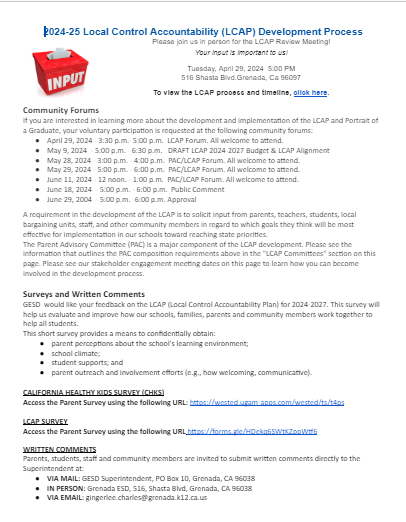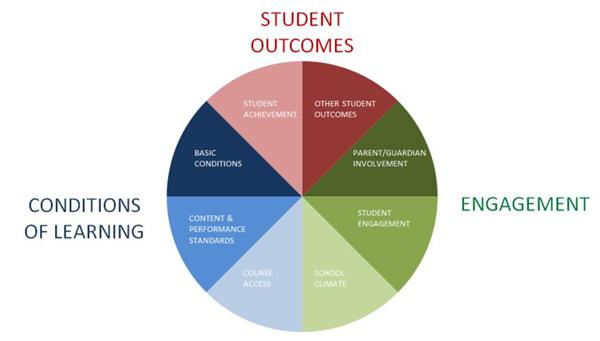SCHOOL PLANS: LCAP, SARC, ESSR, and ELOP
LCAP Priorities
LCFF requires districts to create annual goals in the LCAP and set expected annual measurable objectives (EAMOs) to monitor progress toward those goals. Progress must be based on identified metrics, which may be quantitative or qualitative. There are specific required elements for measuring progress within the eight priority areas. LEAs may also include a variety of locally determined metrics when creating their LCAP.
Metrics required for each LCFF State Priority are:
Priority 1: Basic Services
Percentage of properly credentialed teachers.
Student access to standards-aligned instructional materials.
Facilities in good repair.
Priority 2: Implementation of State Standards
Implementation of the academic content and performance standards adopted by the State Board.
How the programs and services will enable English learners to access the CCSS and the ELD standards for purposes of gaining academic content knowledge and English language proficiency.
Priority 3: Parent Involvement
Efforts the school district makes to seek parent input in making decisions for the school district and each individual school site.
How the school district will promote parental participation in programs for unduplicated pupils.
How the school district will promote parental participation in programs for individuals with exceptional needs.
Priority 4: Pupil Achievement
Statewide assessments.
The percentage of pupils who have successfully completed courses that satisfy the requirements for entrance to the University of California and the California State University. (A-G completion rate).
The percentage of pupils who have successfully completed courses that satisfy the requirements for career technical education sequences or programs of study that align with state board-approved career technical education standards and frameworks. (CTE completion rate)
Percentage of pupils who have successfully completed A-G and CTE course requirements.
Percentage of English learners making progress toward English proficiency as measured by state language proficiency assessment (e.g., English Learner Progress Indicator).
English learner reclassification rate.
Percentage who pass AP exam with score of 3 or higher.
Participation and demonstration of college preparedness (e.g., EAP).
Priority 5: Pupil Engagement
School attendance rates.
Chronic absenteeism rates.
Middle school dropout rates.
High school dropout rates.
High school graduation rates.
Priority 6: School Climate
Pupil suspension rates.
Pupil expulsion rates.
Other local measures, including survey of pupils, parents, and teachers on the sense of school safety and connectedness.
Priority 7: Course Access
Broad course of study that includes all the subject areas described in 51210 and 51220(a)(i) as applicable.
Programs and services developed and provided to unduplicated pupils.
Programs and services developed and provided to students with exceptional needs.
Priority 8: Other Pupil Outcomes
Pupil outcomes if available in the subject areas described in 51210 and 51220(a)(i) as applicable.
Priority 9: Expelled Pupils (Conditions of Learning)(COEs only)
Coordination of instruction for expelled pupils pursuant to Education Code section 48926.
Priority 10: Foster Youth (Conditions of Learning) (COEs only)
Coordination of services, including working with the county child welfare agency to share information, responding to the needs of the juvenile court system, and ensuring the transfer of health and education records.
What is the California School Dashboard?
The California School Dashboard is an online tool that shows how local educational agencies and schools are performing on the state and local indicators included in California's school accountability system. The Dashboard is a key part of major shifts in California K-12 schools, changes that have raised the bar for student learning, transformed testing and placed the focus on equity for all students. The Dashboard provides information that schools can use to improve.
What information does the Dashboard include?
The Dashboard is made up of easy-to-use reports that show local educational agency or school performance on six state indicators and five local indicators (seven for county offices of education). Users can search to see the reports for any local educational agency or school.
What is a local educational agency (LEA)?
Local educational agencies (LEAs) are defined in state law as school districts, county offices of education, and charter schools.
Does the Dashboard include information on all schools and local educational agencies?
All LEAs and traditional schools, including charter schools, will receive accountability results reported within their Dashboard.
The 2018 Dashboard displays reports for alternative schools that are approved under the "Dashboard Alternative Schools Status" (DASS). However, in order to fairly evaluate the performance and progress of DASS schools and the impact that they have on their students, modified methods are being developed to calculate select indicators. For the 2018 Dashboard, modified methods have been approved for the Graduation Rate Indicator.
Why was the Dashboard created?
The Dashboard was created to give parents and the public a better idea of what is happening in our schools and districts and to identify districts and schools that need extra help. The Dashboard is a component of the Local Control Funding Formula law passed in 2013 that significantly changed how California provides funding to public schools and holds local educational agencies accountable for student performance.
The Local Control Funding Formula law required that the State Board of Education adopt a new accountability tool that reflects performance in different priority areas identified in the law. The Dashboard reports performance on the state and local indicators that the State Board of Education included in this new accountability tool.




